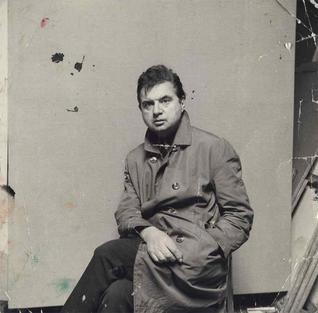
Francis Bacon was an Irish-born British figurative painter known for his raw, unsettling imagery. Focusing on the human form, his subjects included crucifixions, portraits of popes, self-portraits, and portraits of close friends, with abstracted figures sometimes isolated in geometrical structures. Rejecting various classifications of his work, Bacon said he strove to render "the brutality of fact." He built up a reputation as one of the giants of contemporary art with his unique style.

A triptych is a work of art that is divided into three sections, or three carved panels that are hinged together and can be folded shut or displayed open. It is therefore a type of polyptych, the term for all multi-panel works. The middle panel is typically the largest and it is flanked by two smaller related works, although there are triptychs of equal-sized panels. The form can also be used for pendant jewelry.

The painter Francis Bacon was largely self-taught as an artist. As well as other visual artists, Bacon drew inspiration from the poems of T. S. Eliot, Ezra Pound and Yeats, the plays of Aeschylus, Sophocles and Shakespeare; Proust and Joyce's Ulysses.

John Edward McKenzie Lucie-Smith, known as Edward Lucie-Smith, is a Jamaican-born English writer, poet, art critic, curator and broadcaster. He has been highly prolific in these fields, writing or editing over a hundred books, his subjects gradually shifting around the late 1960s from mostly literature to mostly art.
Anthony David Bernard Sylvester was a British art critic and curator. Although he received no formal education in the arts, during his long career he was influential in promoting modern artists, in particular Francis Bacon, Joan Miró, and Lucian Freud.

Three Studies for Figures at the Base of a Crucifixion is a 1944 triptych painted by the Irish-born British artist Francis Bacon. The canvasses are based on the Eumenides—or Furies—of Aeschylus's Oresteia, and depict three writhing anthropomorphic creatures set against a flat burnt orange background. It was executed in oil paint and pastel on Sundeala fibre board and completed within two weeks. The triptych summarises themes explored in Bacon's previous work, including his examination of Picasso's biomorphs and his interpretations of the Crucifixion and the Greek Furies. Bacon did not realise his original intention to paint a large crucifixion scene and place the figures at the foot of the cross.

Study for Crouching Nude is an oil painting on canvas by the Irish-born artist Francis Bacon. It was painted in the spring of 1952 and shows a perched figure whose form was likely derived from Muybridge's Man Performing a Standing Jump. The painting was first displayed – in place of Study for Portrait (1949) – at Recent Trends in Realist Painting at the Institute of Contemporary Arts, London, from July to August 1952. It is held at the Detroit Institute of Arts.
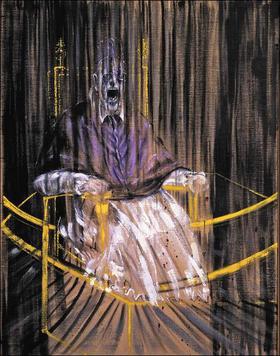
Study after Velázquez's Portrait of Pope Innocent X is a 1953 painting by the artist Francis Bacon. The work shows a distorted version of the Portrait of Innocent X painted by Spanish artist Diego Velázquez in 1650. The work is one of the first in a series of around 50 variants of the Velázquez painting which Bacon executed throughout the 1950s and early 1960s. The paintings are widely regarded as highly successful modern re-interpretations of a classic of the western canon of visual art.

The Museum of Fine Arts of Lyon is a municipal museum of fine arts in the French city of Lyon. Located near the Place des Terreaux, it is housed in a former Benedictine convent which was active during the 17th and 18th centuries. It was restored between 1988, and 1998, remaining open to visitors throughout this time despite the ongoing restoration works. Its collections range from ancient Egyptian antiquities to the Modern art period, making the museum one of the most important in Europe. It also hosts important exhibitions of art, for example the exhibitions of works by Georges Braque and Henri Laurens in the second half of 2005, and another on the work of Théodore Géricault from April to July 2006. It is one of the largest art museums in France.
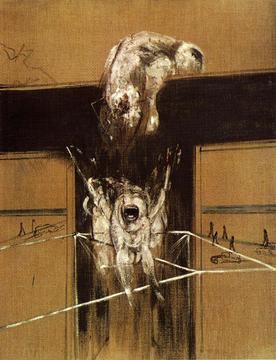
Fragment of a Crucifixion is an unfinished 1950 painting by the Irish-born figurative painter Francis Bacon. It shows two animals engaged in an existential struggle; the upper figure, which may be a dog or a cat, crouches over a chimera and is at the point of kill. It stoops on the horizontal beam of a T-shaped structure, which may signify Christ's cross. The painting contains thinly sketched passer-by figures, who appear as if oblivious to the central drama.

Robert Priseman is a British artist, collector, writer, curator and publisher who lives and works in Essex, England. Over 200 works of art by Priseman are held in art museum collections around the world including the V&A, Museum der Moderne Salzburg, Art Gallery of New South Wales, Musée de Louvain la Neuve, The Royal Collection at Windsor Castle, The Allen Memorial Art Museum, The Mead Art Museum, Honolulu Museum of Art and The National Galleries of Scotland.
Martin Harrison is a British art historian, author and curator, noted for his work on photography, on the medium of stained glass and its history, and as an authority on the work of the painter Francis Bacon.
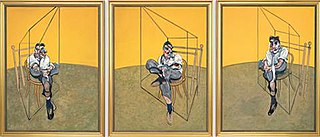
Three Studies of Lucian Freud is a 1969 oil-on-canvas triptych by the Irish-born British painter Francis Bacon, depicting artist Lucian Freud. It was sold in November 2013 for US$142.4 million, which at the time was the highest price attained at auction for a work of art when not factoring in inflation. That record was surpassed in May 2015 by Version O of Picasso's Les Femmes d'Alger series.
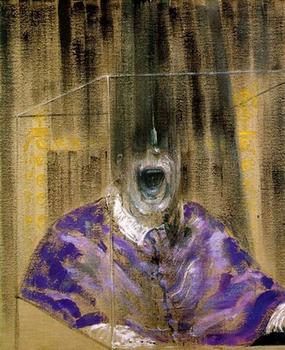
Head VI is an oil-on-canvas painting by Irish-born figurative artist Francis Bacon, the last of six panels making up his "1949 Head" series. It shows a bust view of a single figure, modeled on Diego Velázquez's Portrait of Innocent X. Bacon applies forceful, expressive brush strokes, and places the figure within a glass cage structure, behind curtain-like drapery. This gives the effect of a man trapped and suffocated by his surroundings, screaming into an airless void. But with an inverted pathos is derived from the ambiguity of the pope's horrifying expression—whose distorted face either screams of untethered hatred towards the viewer or pleads for help from the glass cage—the question of what he is screaming about is left to the audience.

Portrait of Isabel Rawsthorne Standing in a Street in Soho is a 1967 oil-on-canvas painting by the Irish-born English figurative artist Francis Bacon, housed in the Neue Nationalgalerie, Berlin. Described by art critic John Russell as one of Bacon's finest works, it depicts Isabel Rawsthorne, the painter, designer and occasional model for artists such as André Derain, Alberto Giacometti and Picasso.

Three Figures in a Room is a 1964 oil-on-canvas triptych painting by British artist Francis Bacon. Each panel measures 198 × 147 centimetres (78 × 58 in) and shows a separate view of his lover George Dyer, whom Bacon first met in 1963. It is the first of Bacon's works to feature Dyer, a model to whom he returned repeatedly in his paintings. The work has been described as Bacon's first secular triptych.
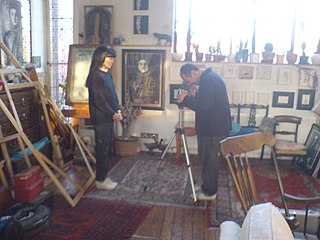
Clare Noel Shenstone is an English artist. She is considered notable for her cloth relief heads and her figure drawings. Her portraits hang in some major British collections including the National Portrait Gallery and the Sainsbury Centre for Visual Arts.

Francis Bacon: The Logic of Sensation is a 1981 book by philosopher Gilles Deleuze, analyzing the work of twentieth-century British figurative painter Francis Bacon. In this biography, Deleuze discusses aesthetics, objects of perception ('percepts'), and sensation.
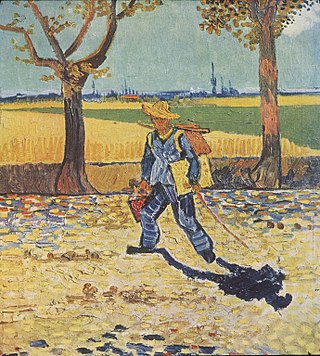
The Painter on the Road to Tarascon, also known as Painter on His Way to Work, is a 1888 painting by Vincent van Gogh that is believed to have been destroyed during the Second World War during an air raid on Germany.
















